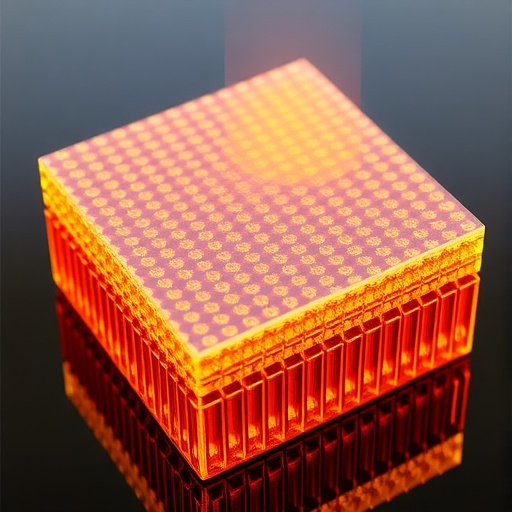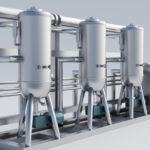
In an unprecedented leap forward for superconducting technology, researchers have unveiled an integrated modeling framework that precisely predicts and optimizes the properties of YBa₂Cu₃O₇ (YBCO) superconducting films. This ground-breaking work, recently published in Communications Engineering, heralds a new era where data-driven insights and rigorous physical models converge to accelerate process design in advanced materials science. The interdisciplinary team, led by Horide, Okumura, and Ito, has crafted a sophisticated synthesis of computational modeling and experimental validation, marking a transformative stride toward realizing the full potential of high-temperature superconductors.
YBCO, a well-known high-temperature superconductor, has long captivated scientists with its exceptional ability to conduct electricity without resistance above the boiling point of liquid nitrogen. Its applications span from powerful electromagnets, MRI machines, and fault-current limiters to the tantalizing prospects of lossless power grids and ultra-fast quantum computing circuits. Yet, despite decades of research, the fabrication of high-quality YBCO thin films with precisely tailored superconducting properties remains a formidable challenge. The new study decisively addresses this gap, integrating physical process understanding and data analytics into a comprehensive modeling platform.
At the core of this research lies the fundamental recognition that the performance of YBCO films hinges exquisitely on the minutiae of their fabrication processes. Parameters such as deposition temperature, oxygen partial pressure, cooling rate, and substrate characteristics intricately influence the film’s microstructure, oxygen stoichiometry, and crystallinity. These factors, in turn, dictate critical properties including the critical current density (Jc), critical temperature (Tc), and magnetic flux pinning capabilities. The authors deploy an integrated process-property modeling approach to unravel these intricate cause-effect relationships, ushering in an era of predictive, model-guided synthesis.
.adsslot_RU31wCIzVg{ width:728px !important; height:90px !important; }
@media (max-width:1199px) { .adsslot_RU31wCIzVg{ width:468px !important; height:60px !important; } }
@media (max-width:767px) { .adsslot_RU31wCIzVg{ width:320px !important; height:50px !important; } }
ADVERTISEMENT
Methodologically, the team leveraged a combination of first-principles calculations, kinetic Monte Carlo simulations, and machine learning algorithms trained on extensive experimental data sets. This hybrid approach allows the model not only to simulate the thermodynamics and kinetics of film growth at the atomic scale but also to accommodate the stochastic variability inherent to real-world manufacturing environments. By bridging physics-based simulations with data-driven insights, the model attains unparalleled predictive power in estimating how specific process parameters propagate to final film qualities.
One of the pivotal achievements reported is the model’s ability to forecast the oxygen content distribution within the YBCO lattice with remarkable accuracy. Oxygen stoichiometry, often a bottleneck in achieving optimal superconducting behavior, profoundly impacts the electron pairing mechanisms fundamental to superconductivity. Here, the model dynamically correlates oxygen diffusion profiles during cooling phases with ambient oxygen atmospheres, providing actionable guidelines for controlling oxygen uptake and vacancy formation. This capability addresses a long-standing obstacle in reproducibly tailoring YBCO films’ superconducting phase purity.
Further, the researchers demonstrated that by iteratively refining process parameters via their integrated model, they could maximize the critical current density, a key benchmark of superconducting performance. This optimization was validated experimentally, where the predicted conditions yielded YBCO films exhibiting significantly enhanced Jc values at liquid nitrogen temperatures relative to conventional methods. Such performance boosts have immediate implications for the commercial viability of YBCO-based devices, promising more efficient, smaller, and cost-effective superconducting components.
Beyond optimizing individual parameters, the integrated framework uniquely captures interdependencies and non-linear effects within the fabrication workflow. For example, subtle variations in substrate surface morphology can cascade through the deposition kinetics to alter grain boundary distributions and defect landscapes. The authors’ simulations elucidate these complex feedback loops and suggest process windows that balance competing effects to achieve optimal film uniformity and superconducting domain size. This holistic understanding empowers precision engineering rarely attainable through empirical trial-and-error approaches alone.
The study also underscores the scalability of their approach, highlighting how the modeling framework can be adapted to accommodate different deposition techniques such as pulsed laser deposition (PLD), chemical vapor deposition (CVD), or metal-organic deposition (MOD). By incorporating technique-specific parameters and reaction kinetics, the model offers a flexible platform readily extensible to diverse manufacturing scenarios. This adaptability stands to accelerate innovation cycles as new material systems and device architectures emerge within the superconductivity arena.
From a broader perspective, the integration of data-driven machine learning models with physically grounded simulations embodies the future of materials science, where “digital twins” of fabrication processes guide both fundamental research and industrial production. The authors’ work exemplifies how marrying mechanistic understanding and empirical data leads to not only predictive but prescriptive process designs. This paradigm shift, demonstrated here on YBCO films, paves the way for similarly transformative strategies across other complex oxide materials and thin-film technologies.
Critically, this advancement comes at a moment when energy sustainability and technological miniaturization demand revolutionary improvements in material efficiency and functional performance. High-temperature superconductors like YBCO hold immense promise for lossless power transmission, efficient magnetic confinement in fusion reactors, and cutting-edge quantum devices. By enabling systematic, model-informed fabrication, the new integrated modeling framework could drastically shorten development timelines and reduce costly experimental iterations, hastening the transition from lab discoveries to market-ready innovations.
Beyond immediate technical gains, the open architecture of the modeling platform encourages collaborative development, inviting researchers worldwide to contribute new data and refine the model iteratively. Such community-driven enhancement fosters a robust ecosystem where collective intelligence accelerates knowledge accumulation and process refinement. This open-science ethos resonates strongly in the modern research landscape, amplifying the broader impact of the reported work.
In essence, Horide, Okumura, Ito, and colleagues have illuminated a transformative path forward for complex material fabrication, showcasing how integrated data and model-driven process design unlocks unprecedented control over superconducting film properties. Their study represents a milestone, bridging theoretical rigor and practical application in a domain often resistant to predictive modeling due to intricate multi-scale phenomena and process variability. The insights gleaned not only deepen our understanding of YBCO superconductors but also establish a blueprint applicable to myriad functional materials reliant on precise thin-film engineering.
Looking ahead, the implications of this research extend well beyond the scientific community into industries seeking rapid, reliable production of high-performance superconducting components. The ability to reliably engineer films with tailored properties has direct relevance for the next generation of medical imaging devices, high-capacity energy storage systems, and quantum computing hardware. As the model continues to evolve with incoming data and computational advances, it will likely catalyze breakthroughs that transcend current technological limitations.
In summation, this pioneering integrated process-property modeling study stands as a beacon showcasing the power of converging physics, computation, and data science to solve long-standing materials challenges. By unlocking a data- and model-driven approach to YBa₂Cu₃O₇ superconducting film design, the researchers not only advance the frontiers of superconductivity but also exemplify a versatile paradigm poised to transform materials engineering on a global scale. The future of superconducting technologies may well be shaped by these digital innovations, ushering an era of smarter, faster, and more sustainable process development.
Subject of Research: Integrated process-property modeling of YBa₂Cu₃O₇ (YBCO) superconducting film for data- and model-driven process design.
Article Title: Integrated process-property modeling of YBa₂Cu₃O₇ superconducting film for data and model driven process design.
Article References:
Horide, T., Okumura, S., Ito, S. et al. Integrated process-property modeling of YBa₂Cu₃O₇ superconducting film for data and model driven process design. Commun Eng 4, 114 (2025). https://doi.org/10.1038/s44172-025-00434-1
Image Credits: AI Generated
Tags: advanced materials researchapplications of YBCO filmschallenges in superconducting film fabricationcomputational modeling in superconductorsdata-driven design in materials scienceexperimental validation of YBCO filmsfuture of lossless power grids and quantum computinghigh-temperature superconductors technologyintegrating physical models and data analyticsinterdisciplinary approach to superconductorsoptimization of superconducting propertiesYBa2Cu3O7 superconducting films



